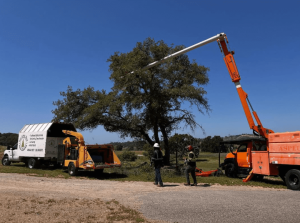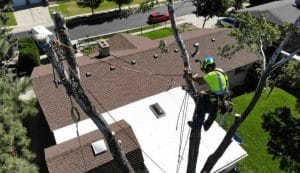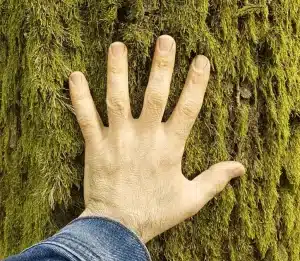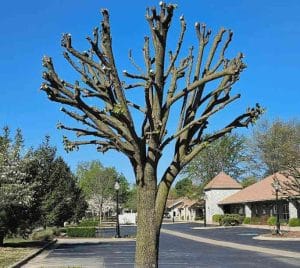Yes, trimming a pine tree can kill it if done the wrong way. Cutting too deeply into live branches or removing the top leader can leave permanent damage and even kill the tree. But when trimmed properly and at the right time of year, pruning actually helps pine trees stay strong, safe, and attractive.
Pine trees add beauty, shade, and value to your property, but trimming them incorrectly can leave lasting damage. In some cases, it can even kill the tree. If you’re wondering whether pruning your pine will hurt or help it, the short answer is: it depends on how, when, and how much you trim. One technique we recommend, when done correctly, is light seasonal pruning that keeps the tree healthy without cutting into its core structure. This approach helps the tree thrive and prevents stress. Keep reading to learn exactly how to trim your pine tree safely, avoid the biggest mistakes homeowners make, and protect your landscape from costly damage.
Table of Contents
Why People Trim Pine Trees in the First Place
People trim pine trees to keep them healthy, safe, and visually appealing. Pruning helps remove dead or diseased branches, reduces the risk of storm damage, allows more sunlight for surrounding plants, and prevents branches from interfering with homes, fences, or power lines. Some also trim for shaping and appearance. While these are all valid reasons, pine trees don’t respond to cuts like many other trees. Removing too much live wood can cause lasting damage that doesn’t grow back, so trimming must always be done with care.

Can Trimming a Pine Tree Kill It?
Yes, trimming a pine tree can kill it if it’s done incorrectly. Pines don’t regrow from old wood the way hardwood trees do, so cutting too deeply into live branches or removing the central leader (the main top shoot) can cause permanent damage. Over-trimming also stresses the tree by reducing its ability to produce food, making it more vulnerable to pests and disease. With careful, selective pruning, however, pine trees can stay healthy, but one wrong cut may lead to long-term decline or even death.
Safe Trimming Techniques for Pine Trees
The safest way to trim a pine tree is through seasonal selective pruning, which means removing only small, targeted branches while leaving the tree’s main structure intact. This method protects the central leader, avoids over-stressing the tree, and keeps it healthy long term.
Steps to Safely Trim a Pine Tree:
- When in doubt, remove less rather than more.
- Use sharp, clean shears or a pruning saw.
- Focus only on dead, diseased, or damaged branches.
- Leave the central leader (top shoot) untouched.
- Limit live branch removal to small sections.
- Cut just outside the branch collar, never into the trunk.
Best Time of Year to Trim a Pine Tree (And Why It Matters)
The best time to trim a pine tree is late winter to early spring, just before new growth begins. During this period, the tree is dormant, which reduces stress and helps wounds heal more efficiently. Pruning in cooler months also minimizes sap loss and lowers the risk of insect infestations or fungal infections entering fresh cuts. Summer or hot-weather trimming should be avoided unless it’s an emergency, since cutting during active growth can weaken the tree and leave it more vulnerable to pests and disease.
Common Trimming Mistakes That Kill Pines
Here are mistakes to avoid and why they’re harmful:
| Mistake | Why It Kills the Tree |
|---|---|
| Topping the tree | Removes the leader, causing weak regrowth and long-term instability. |
| Cutting into the trunk | Leaves permanent wounds that attract pests and rot. |
| Over-pruning lower branches | Exposes the trunk, stresses the canopy, and makes the tree unstable. |
| Trimming in hot months | Increases sap loss, insect activity, and infection risk. |
| Using dull/dirty tools | Crushes bark and spreads disease. |
How Much Can You Trim Without Killing the Tree?
Pine trees are sensitive to heavy pruning. Here’s a general rule of thumb:
Never remove more than 25% of the tree’s live crown (the leafy area) in a single year.
Taking more than that can shock the tree, reduce its ability to photosynthesize, and make it more vulnerable to disease or drought.
Also, avoid cutting the main central leader or too many lower limbs at once. The more drastic the change, the harder it is for the tree to recover.
The Worst Mistakes That Can Kill Your Pine Tree
Trimming mistakes are more common than most people think. Here are some of the biggest ones to avoid:
1. Topping the Tree
This is when someone cuts off the entire top of the tree. It weakens the tree and often causes multiple weak stems to grow back. These rarely survive long-term and can be dangerous.
2. Cutting into the Trunk
Removing limbs too close to the trunk or cutting into the trunk itself leaves open wounds that won’t heal properly and invite rot or bugs.
3. Removing Too Many Lower Branches
Also called “lion-tailing,” this leaves a tall bare trunk with a poof of green at the top. It looks odd and puts stress on the upper limbs.
4. Trimming During Hot Months
As mentioned earlier, this leads to more sap loss and pest activity, which can overwhelm the tree’s ability to heal.
5. Using Dull or Dirty Tools
Dirty tools spread disease. Dull ones crush rather than cut. Both hurt the tree more than they helped.
Signs You Trimmed Too Much
Signs you trimmed a pine tree too much include large areas of browning needles, bare limbs that don’t grow back, excessive sap oozing from cuts, fungal growth on the bark, splitting, or visible leaning and instability. If your tree appears weak for weeks after heavy pruning, it may already be in serious trouble, and contacting a certified arborist quickly is the best chance to help it recover.
Benefits of Trimming Pine Trees the Right Way
When done properly, trimming a pine tree provides many benefits, including preventing branches from interfering with structures or power lines, removing storm hazards, improving airflow through the canopy, reducing the spread of disease, and preserving the tree’s natural shape and longevity. The key is balancing health with appearance and safety. A well-maintained pine tree not only stays stronger and healthier but also adds property value and reduces the likelihood of needing costly removal later.
Should You Trim a Pine Tree Yourself or Hire a Pro?
You can trim a small pine tree yourself if it only needs light shaping, but larger or older trees near homes or power lines should be handled by a certified arborist. Pruning safely requires knowledge of tree biology, clean and sharp tools, and the judgment to know which branches to remove without causing harm. Professionals not only use proper equipment and techniques but can also spot hidden weaknesses or diseases, making them the safer choice when the risks are higher.
How Pine Trees Heal (And What You Can Do to Help)
Pine trees don’t heal by sealing cuts with new growth; instead, they protect wounds through a slow process called compartmentalization, where the tree forms barriers around the damaged area. To help this process, always make clean cuts just outside the branch collar, avoid using sealants that trap moisture, limit the removal of live growth, keep the tree well-watered during dry periods, and watch for stress signals such as needle drop or bark damage. With proper care, a healthy pine can recover from light pruning and continue to thrive.
Final Thoughts: Don’t Be Afraid to Trim, But Do It Smart
Pine trees don’t need constant trimming, but when they do, it has to be done the right way. A single bad cut can set off a chain reaction that weakens or even kills the tree.
The good news is that with the right timing, light touch, and careful technique, you can keep your pine tree strong, healthy, and attractive for years to come.
If you’re unsure about your next steps, consider having a tree expert inspect your pine before you trim. One mistake can cost more than the price of a simple consultation and the peace of mind is worth it.
FAQs
Can trimming a pine tree kill it?
Yes—it can die if you remove too much live foliage or cut into old wood. Pine trees can’t regrow from bare trunks. Trimming more than 25% of the leafy crown or cutting the main top (central leader) risks serious damage or death over time.
When is best time to trim pine trees?
How much of pine tree can you trim?
What happens if you top a pine tree?
How do pine trees heal after trimming?
Pines don’t seal like hardwoods, they compartmentalize wounds slowly by forming barriers. You should make clean cuts outside the branch collar and avoid sealants. Keeping the tree watered and limiting cuts helps it heal better.
What tools work best for pine pruning?
Can I trim pine trees in summer?
Should I hire a pro to trim my pine?
If the tree is tall, near houses or power lines, or requires heavy pruning, hiring a certified arborist is smart. They use safe techniques, know how to avoid fatal cuts, and can diagnose hidden issues.




